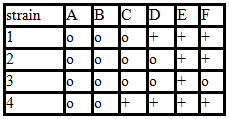A paleontologist has recovered a bit of tissue from the 400-year-old preserved skin of an extinct dodo (a bird). To compare a specific region of the DNA from the sample with DNA from living birds, which of the following would be most useful for increasing
the amount of dodo DNA available for testing?
A) RFLP analysis
B) polymerase chain reaction (PCR)
C) electroporation
D) gel electrophoresis
E) Southern blotting
Answer: B
You might also like to view...
Adjacent plant cells utilize ____ to rapidly communicate with each other
a. gap junctions b. plasmodesmata c. transport proteins d. desmosomes e. neurotransmitters
Which biochemical pathway fits the data presented?
Assume that a series of compounds has been discovered in Neurospora. Compounds A–F appear to be intermediates in a biochemical pathway. Conversion of one intermediate to the next is controlled by enzymes that are encoded by genes. Several mutations in these genes have been identified and Neurospora strains 1–4 each contain a single mutation. Strains 1-4 are grown on minimal media supplemented with one of the compounds A-F. The ability of each strain to grow when supplemented with different compounds is shown in the table (+ = growth; o = no growth).
media supplement

A) A ? B ? C ? D ? E ? F
B) A ? B ? C ? F ? D ? E
C) F ? B ? C ? D ? A ? E
D) A ? B ? C ? D ? F ? E
E) A ? B ? F ? E ? C ? D
Which of the following is least likely to be preserved as a fossil?
A. an organ like an eye or lung B. a bone or shell C. an organism that died on land D. a complete large organism E. a leaf or stem
Which of the following biomes will receive migratory animals, such as caribou, from the tundra?
A. polar ice B. grasslands C. temperate deciduous forest D. coniferous forest E. tropical rain forest